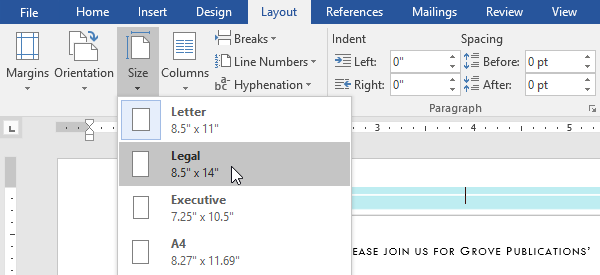
- #HOW SET DEFAULT LAYOUT IN WORD 2016 INSTALL#
- #HOW SET DEFAULT LAYOUT IN WORD 2016 UPGRADE#
- #HOW SET DEFAULT LAYOUT IN WORD 2016 SERIES#
Understand that when you make all these changes, there are still a couple of settings that can then only be changed by a complete reinstall. You are asked if you want to really delete the key.

Choose the Run option from the Start menu.You may want to protect yourself from potential problems by backing up the Registry first, and then you can accomplish the following steps: This is not the end of the process you also need to make a few changes to the Registry. You should also remove any files from the Startup folder. In fact, it is a good idea to look for any file that begins with the word "Normal" and then look at the filename extensions for those files to determine if you should rename them. You should make sure you rename the Normal.dotx file to a different name. If you make changes and then exit, you overwrite any resetting you did. This is because Word saves configuration information as it exits. You should remember that you cannot do "resetting" of Word while the program is running. Thus, after an uninstall, it is likely to be necessary to edit the Registry to remove the settings.
#HOW SET DEFAULT LAYOUT IN WORD 2016 INSTALL#
However, it's not so useful for those who are looking to get a completely 'clean' install with no throwbacks to previous installs.
#HOW SET DEFAULT LAYOUT IN WORD 2016 UPGRADE#
This is ideal for those who are upgrading-they get to keep their settings rather than find the upgrade overwriting them. The uninstall process does not remove all option settings stored in the Registry and many of these will be picked up after the re-install so that Word can use them. Many of the configuration settings unique to Word are stored in the Registry. This, however, will not lead to a pristine version of Word. Other suggestions may include uninstalling and reinstalling Word. While this will restore some settings to their first-used state (such as macros, toolbars, and the like), it will not do the entire trick. Many people think that the easiest way to do this is to simply allow Word to recreate the Normal.dot template. For instance, you may be offering Word training, and you want to reset Word between each class offered. It is saved under Document Themes under the Templates folder.There may be times when you want to set Word back to a pristine, first-installed condition. Make sure that for Save as type, “Office Theme” is selected.įor this example, I have saved it using the filename “Theme LG Default”.

Once you have finalized the tweaks for all three components, you can save it as a theme. To do this:ĥ. Apart from defining colors, the fonts and effects can be defined as well. In the window popup, c hange the colors according to your preferred palette.Īs an example, I renamed the theme as “LG Default 1”. You will find the new custom theme under Page Layout > Colors.
#HOW SET DEFAULT LAYOUT IN WORD 2016 SERIES#
Įach newly-created chart applies the Office theme by default, and so, p re-defining the colors of Series 1, Series 2, and so on, and then saving it as a theme will save you the time of having to change them every time you add a new chart.Ĥ. This is especially significant when you need to create charts and you want them to look uniform using a certain color palette for the lines and bars.

A theme is a combination of colors, fonts and effects.


 0 kommentar(er)
0 kommentar(er)
